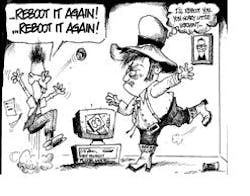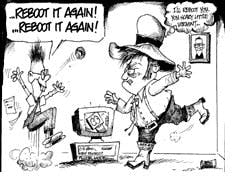Banging and rapping
Greg McMillan and Stan Weiner, PE, bring their wits and more than 66 years of combined process control experience to bear on your questions, comments and problems.
Greg: The response to the July puzzler that posed the wrenching question why operators repeatedly banged on large case instruments with channel-lock pliers before taking readings knocked us out of our easy chairs.Stan: We got answers that hit the mark from Jerry Fridley, John Johansen, Rajasekar and Bill Wilson, plus some particularly interesting scenes and anecdotes from Martin Davis, Jack Funderburk, Bob Johnson, Gary Steinbaugh and Hunter Vegas.Martin: Banging on the case frees the pen and allows the operator to see the actual present value, as well as what direction the pen is moving, quite common at this facility, except the board operators rap on the cases with their knuckles. Maybe it's considered bad form to carry channel-locks in the control room.Jack: Possibly because they couldn't find their adjustable wrenches. More likely, to “encourage” the mechanism's indicator needle to the middle of its range of mechanical hysteresis, thereby minimizing the average error in a sequence of readings. Similar behavior can be observed in calibration labs among technicians calibrating pressure gauges with deadweight testers (but they usually tap more gently).Bob: This one is easy for someone who has been in the trade for a long time, (45 years). Large case instruments, pneumatic or electric, had a mechanical part to them like the pen or pointer movement. The movements always had a certain amount of sticktion or deadband. Operators would tap the case and the indicator or pen would settle into a more accurate position. Who hasn't tapped on a pressure gage for the same reason? I remember in the â60s that there was actually an aftermarket attachment for gages and board instruments called a gage rapper for doing this automatically. It didn't stay on the market very long because people liked to do their own tapping.Gary: I have seen plant operators bang on large case instruments with big channel-locks for one of three reasons: one, they just really hated the readings that were being displayed, two, the instrument bore a striking resemblance to my head, or three, they were trying to defeat the needle “sticktion” and get a better reading. I have often done the latter to airplane instruments (although not with channel-locks) when their indications influenced the success of the flight. Note: I, too, have an extensive collection of slide rules. Now where does that decimal point go?Hunter: Either their instrument air system is not very clean (too much oil, water,etc.) so all of the "wind-powered" instruments are starting to stick or the plant operators have sadistic tendencies with dreams of entering management.Greg: If you are tired of rapping, you will find that these large case circular chart recorders can be quite handy for a lot of other uses per the following “Top 10 List” complied with the help of John Johansen. Remember, if women don’t find you handsome, at least they can find you handy.Stan: There are many other opportunities for bangers and rappers to break free or just break a rotameter, valve, displacer and float so that it can be replaced with something better.Greg: The equivalent kick in the head for microprocessors and software is a reboot.Stan: Our September Puzzler is for all our seasoned readers who get all the angles. What was the single greatest innovation in the 1960s in terms of saving engineering time on large projects?Greg: Now for this month’s disclaimer. The last time we were rebooted was some time back in the '70's.
Top 10 Handy Uses for Large Case Circular Chart Recorders
10. Big bird feeders, or in my case squirrel feeders.9. Flower plantersyou can pass them off as antiques.8. Portrait frames for your long-lost relatives.7. Halloween masks for aspiring engineers.6. Piggy banks so you can get the money back out.5. Storage for your memorabilia; such as valve-sizing slide rulers.4. High-tech picnic gamesstand back 20 ft. and toss your CDs.3. Great nautically themed lockers with those neat portholes.2. Bourdon tubes make a nice fishing lures—just add treble hooks.1. Toilet seats for the family out houseswhat an appropriate end!
This Month’s Puzzler: How Did Engineers Save Time in the '60s?
What was the single greatest innovation in the 1960s in terms of saving engineering time on large projects? Send an e-mail with your answer to the Puzzler, control questions or comments to [email protected].
Greg: The response to the July puzzler that posed the wrenching question why operators repeatedly banged on large case instruments with channel-lock pliers before taking readings knocked us out of our easy chairs.Stan: We got answers that hit the mark from Jerry Fridley, John Johansen, Rajasekar and Bill Wilson, plus some particularly interesting scenes and anecdotes from Martin Davis, Jack Funderburk, Bob Johnson, Gary Steinbaugh and Hunter Vegas.Martin: Banging on the case frees the pen and allows the operator to see the actual present value, as well as what direction the pen is moving, quite common at this facility, except the board operators rap on the cases with their knuckles. Maybe it's considered bad form to carry channel-locks in the control room.Jack: Possibly because they couldn't find their adjustable wrenches. More likely, to “encourage” the mechanism's indicator needle to the middle of its range of mechanical hysteresis, thereby minimizing the average error in a sequence of readings. Similar behavior can be observed in calibration labs among technicians calibrating pressure gauges with deadweight testers (but they usually tap more gently).Bob: This one is easy for someone who has been in the trade for a long time, (45 years). Large case instruments, pneumatic or electric, had a mechanical part to them like the pen or pointer movement. The movements always had a certain amount of sticktion or deadband. Operators would tap the case and the indicator or pen would settle into a more accurate position. Who hasn't tapped on a pressure gage for the same reason? I remember in the â60s that there was actually an aftermarket attachment for gages and board instruments called a gage rapper for doing this automatically. It didn't stay on the market very long because people liked to do their own tapping.Gary: I have seen plant operators bang on large case instruments with big channel-locks for one of three reasons: one, they just really hated the readings that were being displayed, two, the instrument bore a striking resemblance to my head, or three, they were trying to defeat the needle “sticktion” and get a better reading. I have often done the latter to airplane instruments (although not with channel-locks) when their indications influenced the success of the flight. Note: I, too, have an extensive collection of slide rules. Now where does that decimal point go?Hunter: Either their instrument air system is not very clean (too much oil, water,etc.) so all of the "wind-powered" instruments are starting to stick or the plant operators have sadistic tendencies with dreams of entering management.Greg: If you are tired of rapping, you will find that these large case circular chart recorders can be quite handy for a lot of other uses per the following “Top 10 List” complied with the help of John Johansen. Remember, if women don’t find you handsome, at least they can find you handy.Stan: There are many other opportunities for bangers and rappers to break free or just break a rotameter, valve, displacer and float so that it can be replaced with something better.Greg: The equivalent kick in the head for microprocessors and software is a reboot.Stan: Our September Puzzler is for all our seasoned readers who get all the angles. What was the single greatest innovation in the 1960s in terms of saving engineering time on large projects?Greg: Now for this month’s disclaimer. The last time we were rebooted was some time back in the '70's.
Top 10 Handy Uses for Large Case Circular Chart Recorders
10. Big bird feeders, or in my case squirrel feeders.9. Flower plantersyou can pass them off as antiques.8. Portrait frames for your long-lost relatives.7. Halloween masks for aspiring engineers.6. Piggy banks so you can get the money back out.5. Storage for your memorabilia; such as valve-sizing slide rulers.4. High-tech picnic gamesstand back 20 ft. and toss your CDs.3. Great nautically themed lockers with those neat portholes.2. Bourdon tubes make a nice fishing lures—just add treble hooks.1. Toilet seats for the family out houseswhat an appropriate end!
This Month’s Puzzler: How Did Engineers Save Time in the '60s?
What was the single greatest innovation in the 1960s in terms of saving engineering time on large projects? Send an e-mail with your answer to the Puzzler, control questions or comments to [email protected].


